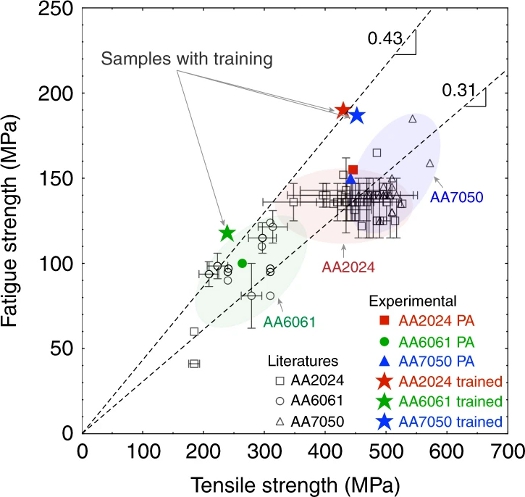 |
| November 24, 2020 | Volume 16 Issue 45 |
Designfax weekly eMagazine
Archives
Partners
Manufacturing Center
Product Spotlight
Modern Applications News
Metalworking Ideas For
Today's Job Shops
Tooling and Production
Strategies for large
metalworking plants
Fatigue life of high-strength aluminum alloys improved 25x
A world-first study by Monash University engineers in Australia has demonstrated improvements in the fatigue life of some high-strength aluminum alloys by 25 times -- a development that could prove to be a significant boon for the transport manufacturing industry.
Published Oct. 15, 2020, in the journal Nature Communications, the researchers demonstrated that the poor fatigue performance of high-strength aluminum alloys was because of weak links called "precipitate free zones" or PFZs.
Led by Professor Christopher Hutchinson, a Professor of Materials Science and Engineering, the team was able to make aluminum alloy microstructures that can heal weak links while in operation (in effect, a form of self-healing).
The improvement in the lifetime of high-strength aluminum alloys could be 25 times compared to current state-of-the-art alloys.
Aluminum alloys are the second most popular engineering alloy in use today. Compared to steel, they are light (one-third the density), non-magnetic, and have excellent corrosion resistance.
These alloys are important for transport applications because they are light, which improves fuel efficiency, but their fatigue properties are notoriously poor compared to steel of similar strength.
Professor Hutchinson said when using aluminum alloys for transport, the design must compensate for the fatigue limitations of aluminum alloys. This means more material is used than manufacturers would like, and the structures are heavier than desired.
"Eighty percent of all engineering alloy failures are due to fatigue. Fatigue is failure due to an alternating stress and is a big deal in the manufacturing and engineering industry," Hutchinson said.
"Think of taking a metal paperclip in your hands and trying to break the metal. One cannot. However, if you bend it one way, then the other, and back and forth a number of times, the metal will break.
"This is 'failure by fatigue,' and it's an important consideration for all materials used in transport applications, such as trains, cars, trucks, and planes."
Failure by fatigue occurs in stages. The alternative stress leads to microplasticity (undergoing permanent change due to stress) and the accumulation of damage in the form of a localization of plasticity at the weak links in the material. The plastic localization catalyzes a fatigue crack. This crack grows and leads to final fracture.

Fatigue strength vs. ultimate tensile strength (UTS) for commercial AA2024, AA7050, and AA6061 alloys. "Trained" alloys were the new variants created for the research. [Chart: Monash University researchers]
Using commercially available AA2024, AA6061, and AA7050 aluminum alloys, researchers used the mechanical energy imparted into the materials during the early cycles of fatigue to heal the weak points in the microstructure (the PFZs).
This strongly delayed the localization of plasticity and the initiation of fatigue cracks, resulting in enhanced fatigue lives and strengths.
Hutchinson said these findings could be significant for the transport manufacturing industry as the demand for fuel-efficient, lightweight, and durable aircraft, cars, trucks, and trains continues to grow.
"Our research has demonstrated a conceptual change in the microstructural design of aluminum alloys for dynamic loading applications," he said.
"Instead of designing a strong microstructure and hoping it remains stable for as long as possible during fatigue loading, we recognized that the microstructure will be changed by the dynamic loading and, hence, designed a starting microstructure (that may have lower static strength) that will change in such a way that its fatigue performance is significantly improved.
"In this respect, the structure is trained, and the training schedule is used to heal the PFZs that would otherwise represent the weak points. The approach is general and could be applied to other precipitate hardened alloys containing PFZs for which fatigue performance is an important consideration."
How'd they do it? In their paper, the researchers say, "The precipitate-strengthened Al alloys obtain their high strength from a fine distribution of nanoscale particles that form by a nucleation and growth process during elevated temperature processing. ... The precipitates in the UA (aged) state are smaller, and the volume fraction reduced, compared to the PA (peak aged) state. The UA heat treatment times are chosen to give a hardening increment approximately half the total hardening increment observed during the PA treatment."
See "Training high-strength aluminum alloys to withstand fatigue" in Nature Communications. Research co-authors are Qi Zhang, Dr. Yuman Zhu, Dr. Xiang Gao, and Dr. Yuxiang Wu (Department of Materials Sciences and Engineering, Monash University).
Source: Monash University
Published November 2020
Rate this article
View our terms of use and privacy policy
